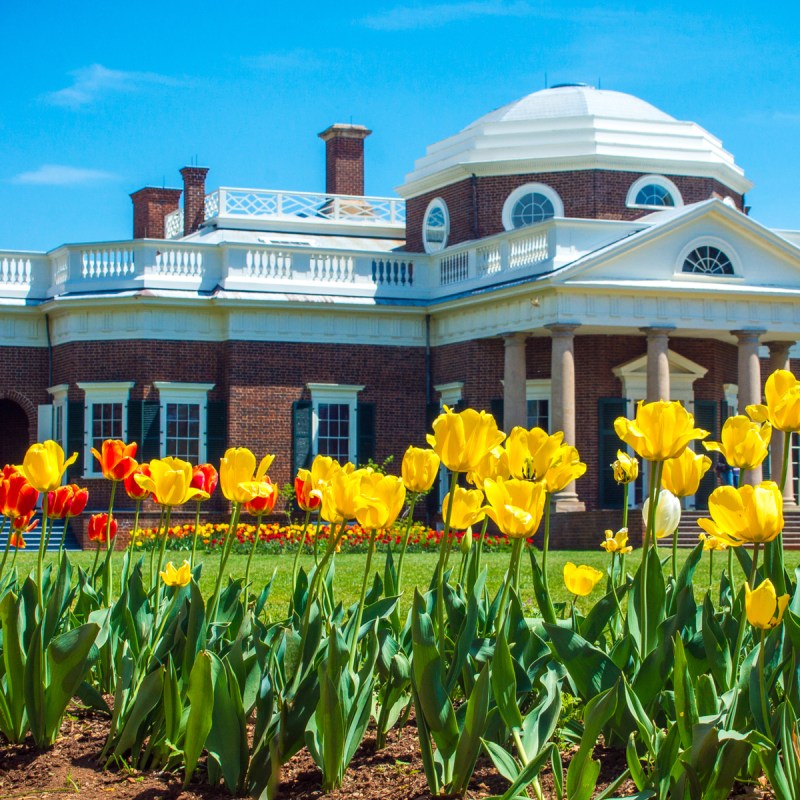
When we first began RVing, I wasn’t yet an American citizen but I had certainly become an American when I finally took the Oath. Learning about U.S. history became a passion and one of my best learning experiences was visiting former Presidents’ homes. They were everything from small, simple cabins to large, luxurious mansions. Each gave me a particular view, not of how he governed but of the man, how he came to be, and how he chose to live. Here are my 12 favorites.
Videos by TravelAwaits

1. George Washington’s Mt. Vernon (1789–1797)
Our first president is George Washington, the larger-than-life general who led the country to victory in the United States’ war for independence. Mt. Vernon, his historic home and estate, is now a National Historic Landmark in Virginia just 13 miles south of Washington, D.C. The family had owned the land since 1674; the original house was built by his father in 1754; and Washington expanded it into a one-and-a-half story mansion in the 1770s. It is a typical southern plantation home but it was the large patio in the back that provided me several minutes of euphoria as I sat on one of the rocking chairs, looking over the wide, historic Potomac River.

2. Thomas Jefferson’s Monticello (1801–1809)
Thomas Jefferson, another Founding Father and principal author of the Declaration of Independence, became our third president. When he was just 26, he inherited Monticello, meaning “little mountain,” situated on an 850-foot-high summit in Charlottesville, Virginia. He designed the plantation house in neoclassical design and improved it while he served as Minister to France by incorporating French elements way ahead of its time. Monticello displayed his architectural brilliance (as with his summer home, Poplar Forest, in Forest, Virginia) and has been designated a National Historic Landmark and UNESCO World Heritage Site.

3. Andrew Jackson (1829–1837)
Three presidents came from Tennessee: Andrew Jackson, James Polk, and Andrew Johnson. The Hermitage is Jackson’s home and it ranks with Mt. Vernon and Monticello as best presidential sites. The legacy of America’s seventh president was the annexation of Arkansas and Michigan but I must say that the Hermitage is another, especially the Greek-inspired tomb and memorial of his beloved wife, Rachel, on the grounds. The two were married in 1791, although, unbeknownst to Rachel, she never divorced her ex-husband, Lewis Robards. After the official divorce, her and Jackson remarried in 1794. Rachel died just a few months before Jackson claimed the presidency in 1829. He never remarried and two women helped him with the social functions of his presidency.
4. James Polk (1845–1849)
Columbia, Tennessee, is where you will find the home of James Polk, our 11th president. Polk only served for one term and died just 3 months after leaving office. He was sickly from the start, but it’s believed that the hard work he put in may have cost him his life. Two portraits in his modest home, taken only 2 years apart, one a year into his term and the other a year before he left office show how much he had aged. Polk led the U.S. to win the Mexican-American War, and his legacy was the annexation of the rest of the West.

5. Abraham Lincoln (1861–1865)
Abraham Lincoln, our 16th president, is frequently cited as the best president we have ever had. He ably led the country during its worst crisis, the Civil War, preserved the Union, and abolished slavery. Such bold actions ultimately cost him his life. His Presidential Library in Springfield, Illinois, is a testament to his greatness. There, he comes alive with holograms and other technology applications. He and his wife Mary, played by actors, welcomed us to his nearby modest, Greek revival-style home. But it was his boyhood home at the Lincoln Birthplace National Historical Park in Hodgenville, Kentucky, that moved me. A humble, tiny cabin where he was born and raised is on display at a simple memorial to which 56 steps, representing his short life, lead.

6. Theodore Roosevelt (1901–1905)
Our 26th president is the youngest we have ever had, rising to the presidency at 42 after President McKinley was assassinated. Still, he made a significant contribution to the country: the Square Deal, the Panama Canal, and conservation as a top national priority, establishing national parks, forests, and monuments. Although we were not able to visit his Sagamore Hill National Historic Site in New York, we saw his birthplace in the city. But it was his Maltese Cross Cabin, on display at the Theodore Roosevelt National Park in North Dakota, that gave us a better understanding of how the man’s love for the great outdoors shaped his conservationist views.

7. William Howard Taft (1909–1913)
When my husband had to have arthroscopic surgery on his right knee, we stayed 3 weeks in Indiana and another 3 weeks in Ohio on campgrounds around Ohio’s Christ’s Hospital for Recovery. It happened that the home of William Howard Taft, our 27th president, was almost in front of the hospital. That was especially meaningful for me, since he was also the first Governor-General of the Philippines when he successfully laid the foundation of my home country’s public systems and infrastructure. This catapulted him into the presidency and his strong judicial background led him to be the only president who later served as Chief Justice of the Supreme Court.

8. Franklin Delano Roosevelt (1933–1945)
Franklin Delano Roosevelt was our 32nd president, serving a record four terms and leading the nation through the Great Depression and WWII. His home, the Springwood Estate in Hyde Park, New York, is a National Historic Site and where the tradition of Presidential Libraries started. The last renovation FDR made doubled the size of the mansion and transformed it into Colonial revival-style. Since it was owned by his mother, he built Top Cottage for his private use and both were fitted for his wheelchair. Towards the end of his presidency, he lived a separate life from his wife Eleanor who had redefined the role of First Lady and became ninth in the Top 10 Most Widely Admired People of the 20th Century. Her home, Val-Kill Cottage, 2 miles from Springwood, is another National Historic Site.

9. Harry Truman (1945–1953)
When Roosevelt died, his vice president Harry Truman became our 33rd president. He is known for authorizing history’s first and only use of nuclear weapons ending WWII; leading the rebuilding of Europe through the Marshall Plan; and establishing the Truman doctrine and NATO. We visited his birthplace in Lamar, Missouri, his home, and the men’s store “Wild About Harry” managed by my husband’s nephew in Independence. Towards the latter part of his presidency, he spent his winters in warmer climes on orders from his doctor. The Little White House in Key West, Florida, originally the officers’ quarters of a submarine naval station converted into the base commandant’s home, became the site of many historic agreements and meetings.
10. Dwight Eisenhower (1953–1961)
Dwight Eisenhower became our 34th president at the end of WWII. A five-star general, he was the Supreme Commander of the Allied Forces in Europe and was responsible for the success of Operation Overlord, the Normandy landings that ended the war in Europe. He authorized the creation of NASA, contributed to the end of McCarthyism, and built the Interstate Highway System leading to widespread economic prosperity. The Eisenhower National Historic Site is near Gettysburg in Pennsylvania, but it was his Boyhood Home and Presidential Library in Abilene, Kansas, which we visited, my husband being a native of Kansas. It is a simple two-story, wood-frame house on an acre of land. It is also his final resting place.

11. John F. Kennedy (1961–1963)
After Eisenhower, John Fitzgerald Kennedy was elected our 35th president. It may have been a short presidency, but it was a beloved one. At the height of the Cold War, his eloquent speeches inspired not only the nation but the world. I was then living in the Philippines and, together with the entire world, mourned his assassination. My husband and I visited the Kennedy Compound in Hyannis Port, Massachusetts, that sits on 6 acres on the Cape Cod waterfront. It was the base for his presidential campaign and later his summer White House. The main house was occupied by the patriarch Joseph Kennedy, and where Edward Kennedy lived until his death. JFK’s smaller home is on Irving Avenue and Robert Kennedy’s is on Marchant Avenue. Unfortunately, none of these are open to the public so we spent the time at the JFK Hyannis Museum nearby.
12. Jimmy Carter (1977–1981)
I was general manager of MegaLink (the ATM consortium of banks in the Philippines) when my staff and I built a home for the Philippine Chapter of Habitat for Humanity. In Georgia, I visited its headquarters in Americus and Atlanta. Its mission was to “eliminate substandard housing and homelessness… and to make decent shelter a matter of… action.” Homes were built using volunteer labor and sold at no profit for affordable monthly payments. That gave me the chance to take a peek at the nearby modest two-bedroom home of our longest-living president, Jimmy Carter, in Plains. Our 39th president may not have had a fully successful presidency but to me, he is a truly inspiring figure who, up to 6 years ago, still went on a Carter-Habitat project every year, with a thousand or so volunteers, to build homes.
There are 10 other presidents’ homes we have seen that I could not include here, and we are still hoping to see the other 24. Visiting presidential homes has been truly instructive for me. They showed me how presidents were influenced to be the men they eventually became and how, in turn, they influenced the country’s history on its path to greatness.

